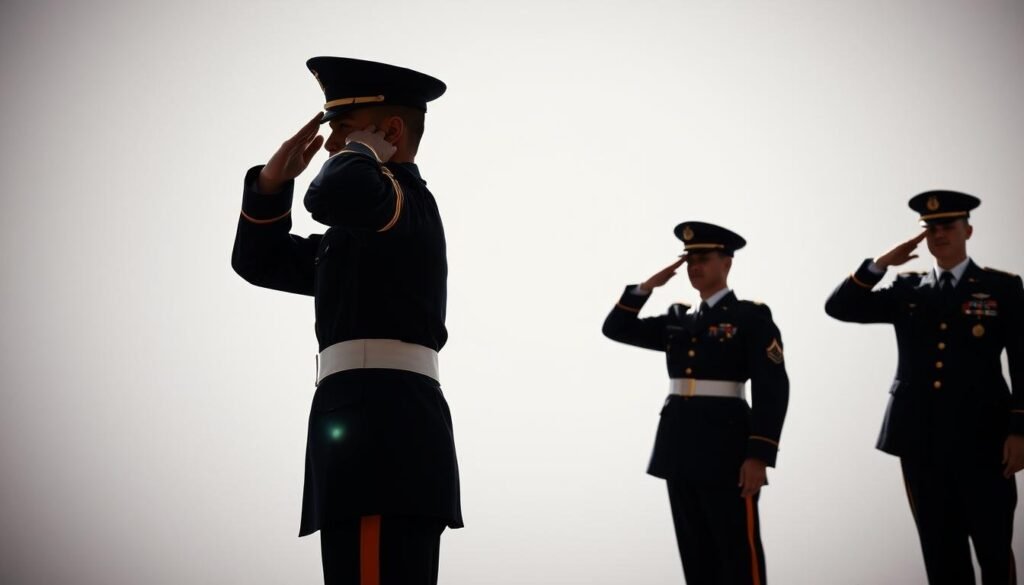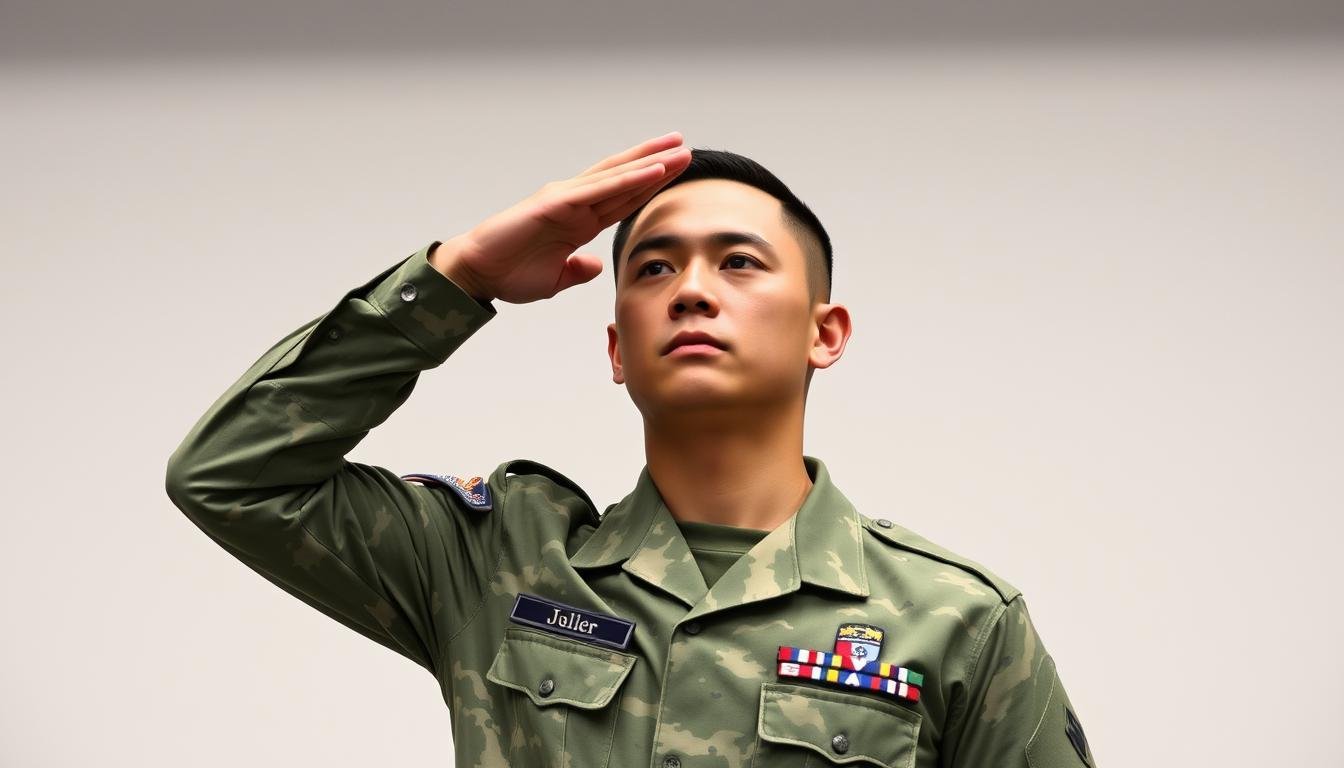Does the Military Salute the Vice President? Ever wondered about the rules of military protocol when it comes to saluting high-ranking officials? The vice president, being the second-in-command in the US government, gets special honors and respect.
Figuring out if the military salute is given to the vice president involves understanding US military customs. You’ll learn about the importance of saluting and its role in showing respect to different officials.
The vice president’s position and the respect they receive come from the US military’s tradition of honoring leaders. This introduction prepares you for a closer look at US military customs and the salute rules.
Contents
- 1 The Military Salute: Purpose and Significance
- 2 Military Protocol: Chain of Command and Saluting
- 3 Does the Military Salute the Vice President? Official Protocols
- 4 Branch-Specific Saluting Protocols
- 5 The Vice President as Commander-in-Chief’s Second
- 6 Comparing Saluting Protocols: President vs. Vice President
- 7 Common Misconceptions About Military Salutes
- 8 Conclusion: Does the Military Salute the Vice President?
- 9 FAQ
- 9.1 Does the military salute the Vice President?
- 9.2 What is the significance of the military salute?
- 9.3 Are there differences in saluting protocols between indoor and outdoor settings?
- 9.4 How do different branches of the military handle saluting protocols?
- 9.5 What is the Vice President’s role in relation to the military?
- 9.6 How do saluting protocols compare between the President and the Vice President?
- 9.7 What are some common misconceptions about military salutes?
- 9.8 Is the Vice President entitled to a military salute when visiting a military base?
- 9.9 How does the military determine who to salute?
The Military Salute: Purpose and Significance
The salute is key in military protocol. It shows the chain of command and discipline. It’s a sign of respect, showing a service member follows military customs.
Why is the salute so important? It’s a visual sign of the military’s structure and discipline. Seeing a service member salute is a moment of respect in military culture.
- Respect for superiors and the chain of command
- Discipline and following military customs
- Unity and cohesion among service members
- A symbol of pride and tradition in the military
Knowing these points helps you see the salute’s role in military protocol. It shows the discipline and respect that are part of military life.
Military Protocol: Chain of Command and Saluting
The chain of command in the military is closely tied to saluting protocols. It’s key to know when and how to salute officials, like the Vice President.
Indoor vs. Outdoor Protocols
Saluting rules change between indoors and outdoors. Outdoor protocols are more formal, requiring salutes for superior officers. Indoor rules are less strict, salutes are not always needed unless it’s formal or when reporting to a superior.
Saluting in Uniform vs. Civilian Attire
In uniform, military people salute as a sign of respect and discipline. But, in civilian clothes, saluting is not needed unless it’s a formal event or ceremony.
| Setting | Uniform/Civilian | Saluting Protocol |
|---|---|---|
| Outdoor | Uniform | Salute required when greeting superior officers |
| Indoor | Uniform | Salute required when reporting to a superior officer or in formal settings |
| Outdoor/Indoor | Civilian | Saluting generally not required unless in formal events or ceremonies |
Knowing these rules helps you understand military etiquette and respect for officers, including the Vice President.
Does the Military Salute the Vice President? Official Protocols
Whether the military salutes the Vice President depends on official rules and legal standards. We need to look into the rules for military salutes and the laws that support the Vice President’s authority.
Legal Basis for Vice Presidential Recognition
The Vice President’s role is set by the U.S. Constitution and laws. As the second-in-command, they handle important tasks like national security and military matters. The laws back the military’s salute to the Vice President because of their duties.
So, how does the military salute protocol work for the Vice President? Military rules dictate when and how to salute officials. The Vice President gets salutes in certain situations because of their government role.
The table below shows the key points of the military salute protocol for the Vice President and other top officials.
| Official | Salute Protocol | Legal Basis |
|---|---|---|
| President | Always saluted | Constitutional authority as Commander-in-Chief |
| Vice President | Saluted under certain circumstances | Statutory and constitutional duties |
| Secretary of Defense | Saluted as a senior official | Statutory authority over the Department of Defense |
In summary, the military salute rules for the Vice President come from the Constitution, laws, and military rules. Knowing these rules helps us understand the respect and honors given to the Vice President as a high-ranking government official.
Branch-Specific Saluting Protocols
Exploring military salutes, you’ll find each branch has its own customs. The core of saluting is the same everywhere. But, the details of how it’s done can differ.
The Army has strict saluting rules, showing respect and discipline. Soldiers salute with their right hand, touching their eyebrow. The Navy sees saluting as a way to show respect to higher-ups.
The Air Force and Marine Corps have their own ways of saluting. The Air Force values a sharp, precise salute. The Marine Corps sees saluting as a sign of brotherhood and respect.
Knowing these branch-specific customs and saluting practices helps us see the military’s diversity. Despite differences, the military protocol of respect ties everything together.
The Vice President as Commander-in-Chief’s Second
The Vice President plays a key role alongside the President, who leads the armed forces. The Vice President is seen as the President’s second in command. This role comes with important duties, especially when the President can’t do their job.
In the military, the Vice President’s role is symbolic, not operational. They don’t command troops directly. Yet, their role is vital for keeping the government and military stable. Military personnel show respect to the Vice President, following specific rules that differ from those for the President.
Showing respect to the Vice President includes saluting, but the details can change. It depends on the military branch and the situation. Knowing these details helps us understand the relationship between civilian leaders and military rules.
Comparing Saluting Protocols: President vs. Vice President
It’s important to know how the President and Vice President are saluted in the military. The President, as the top commander, gets a lot of respect and salutes. This shows their high rank.
The Vice President also gets respect, but in a different way. The salute is a sign of respect and discipline. The rules for saluting the President and Vice President are different.

Looking at the saluting rules, we see the President’s big role. They have the final say over the military. This is why the President gets special salutes.
The Vice President supports the President and takes over if needed. This role is key to understanding why their salutes differ.
In short, the saluting rules for the President and Vice President show their unique roles. By comparing these rules, we learn more about the respect each office gets.
Common Misconceptions About Military Salutes
The military salute is filled with tradition, but many people don’t understand its details. You might be surprised to learn that several common myths surround this gesture of respect.
One common myth is that the military salute is only for formal events. But, saluting is a daily custom in military life. It’s not just a formal gesture; it’s a way of acknowledging someone’s rank and position.
Another myth is that only officers receive salutes. In reality, salutes are exchanged between military personnel as a sign of respect, regardless of their rank. The key is understanding the context and protocol behind the salute.
| Misconception | Reality |
|---|---|
| Salutes are only for formal events. | Salutes are a daily custom in military life. |
| Only officers receive salutes. | Salutes are exchanged between personnel of different ranks. |
| Saluting is optional. | Saluting is a required custom in the military. |
Understanding these nuances can help clarify the significance of the military salute. By dispelling these common misconceptions, you can gain a deeper appreciation for the customs and protocols that govern military life.
Conclusion: Does the Military Salute the Vice President?
You now know how the military salute works and its importance for the Vice President. This salute is a big part of military tradition and shows respect for those in charge.
The Vice President gets saluted by military people in certain situations. This shows their place in the military’s order of rank.
In short, saluting the Vice President is a sign of respect and following rules. It shows how important military customs and traditions are. This summary wraps up the main points we’ve covered.
Learning about military salutes helps you understand the respect and order in military life. It’s especially true when it comes to high officials like the Vice President. This knowledge helps you fully grasp the topic, ending with a clear understanding of the military salute and the Vice President’s role.
See Also: Texas-Born U.S. Presidents: Who Hails from the Lone Star State?
FAQ
Does the military salute the Vice President?
Yes, the military salutes the Vice President as a sign of respect. This follows official protocols and customs.
What is the significance of the military salute?
The military salute shows respect, discipline, and follows military customs. It reflects the chain of command.
Are there differences in saluting protocols between indoor and outdoor settings?
Yes, there are specific protocols for saluting indoors versus outdoors. There are also rules for when in uniform versus civilian attire.
How do different branches of the military handle saluting protocols?
Each branch, like the Army, Navy, Air Force, and Marine Corps, has its own saluting protocols or customs.
What is the Vice President’s role in relation to the military?
The Vice President is the second-in-command to the President. They are treated with respect and protocol accordingly.
How do saluting protocols compare between the President and the Vice President?
Saluting protocols for the President and Vice President share similarities and differences. These reflect their roles and offices.
What are some common misconceptions about military salutes?
Common misconceptions about military salutes include misunderstandings about when and why salutes are given. These can be clarified by understanding military protocol and customs.
Is the Vice President entitled to a military salute when visiting a military base?
Yes, as a high-ranking government official, the Vice President is entitled to a military salute when visiting a military base. This follows standard military protocols.
How does the military determine who to salute?
The military determines who to salute based on official protocols, customs, and the individual’s rank, role, or position. This includes the Vice President.

Hi, I am Tatum Bradford from Washington. I have a background in political science and work as a senior revenue officer. I love learning about U.S. presidents and sharing interesting facts about political history.

